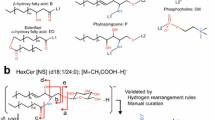Abstract
Alkaline metal adduct ions of sphingomyelin were formed by electrospray ionization in positive ion mode. Under low energy collisionally activated dissociation (CAD), the product ion spectra yield abundant fragment ions representative of both long chain base and fatty acid which permit unequivocal determination of the structure. Tandem spectra obtained by constant neutral loss scanning permit identification of sphingomyelin class and specific long chain base subclass in the mixture. The fragmentation pathways under CAD were proposed, and were further confirmed by source CAD tandem mass spectrometry. The total analysis of sphingomyelin mixtures from bovine brain, bovine erythrocytes, and chicken egg yolk is also presented.
Similar content being viewed by others
References
Sweeley, C. C. Purification and partial characterization of sphingomyelin from human plasma. J. Lipid Res. 1963, 4, 402–406.
Osamu, M.; Tsubono, H.; Akiyama, M.; Sakagami, T. Sphingomyelins in human erythrocytes and plasma. J. Biochem. (Tokyo) 1967, 62, 618–620.
Samuelsson, K. On the occurrence and nature of free ceramides in human plasma. Biochim. Biophys. Acta 1969, 176, 211–213.
Lastennet, A.; Freysz, L.; Bieth, R. Distribution and metabolism of 2 types of sphingomyelins in various zones of the central nervous system. J. Physiol. (Paris) 1970, 62, 289.
Hannun, Y. A. Sphingolipid second messengers: tumor suppressor lipids. Adv. Exp. Med. Biol. 1997, 400A, 305–312.
Hannun, Y. A.; Obeid, L. M.; Wolff, R. A. The novel second messenger ceramide: identification, mechanism of action, and cellular activity. Adv. Lipid Res. 1993, 25, 43–64.
Chao, M. V. Ceramide: a potential second messenger in the nervous system. Mol. Cell Neurosci. 1995, 6, 91–96.
Morrison, W. R.; Hay, J. D. Polar lipids in bovine milk. II. Long-chain bases, normal and 2-hydroxy fatty acids, and isomeric cis and trans monoenoic fatty acids in the sphingolipids. Biochim. Biophys. Acta 1969, 202, 460–467.
Nyberg, L. In Phospholipids: Characterization, Metabolism and Novel Biological Applications; Cevc, G.; Paltauf, F., Eds.; AOCS: Champaign, IL, 1995; p 125.
Minami, H.; Nylander, T.; Carlsson, A.; Larsson, K. Incorporation of proteins in sphingomyelin-water gel phases. Chem. Phys. Lipids 1996, 79, 65–70.
Jungalwala, F. B.; Evans, J. E.; McCluer, R. H. Compositional and molecular species analysis of phospholipids by high performance liquid chromatography coupled with chemical ionization mass spectrometry. J. Lipid Res. 1984, 25, 738–749.
Kim, H. Y.; Salem, N. Jr. Application of thermospray high-performance liquid chromatography/mass spectrometry for the determination of phospholipids and related compounds. Anal. Chem. 1987, 59, 722–726.
Valeur, A.; Olsson, N. U.; Kaufmann, P.; Wada, S.; Kroon, C.-G.; Westerdahl, G.; Odham, G. Quantification and comparison of some natural sphingomyelins by on-line high-performance liquid chromatography/discharge-assisted thermospray mass spectrometry. Biol. Mass Spectrom. 1994, 23, 313–319.
Byrdwell, W. C.; Borchman, D. Liquid chromatography/massspectrometric characterization of sphingomyelin and dihydrosphingomyelin of human lens membranes. Ophtahl. Res. 29, 191, 1997.
Murphy, R. C.; Harrison, K. A. Fast atom bombardment mass spectrometry of phospholipids. Mass Spectrom. Rev. 1994, 13, 57–75.
Ann, Q.; Adams, J. Collision-induced decomposition of sphingomyelins for structural elucidation. Biol. Mass Spectrom. 1993, 22, 285–294.
Kerwin, J. L.; Tuininga, A. R.; Ericsson, L. H. Identification of molecular species of glycerophospholipids and sphingomyelin using electrospray mass spectrometry. J. Lipid Res. 1994, 35, 1102–1114.
Karlsson, A. A.; Michelsen, P.; Odham, G. Molecular species of sphingomyelin: determination by high-performance liquid chromatography/mass spectrometry with electrospray and high-performance liquid chromatography/tandem mass spectrometry with atmospheric pressure chemical ionization. J. Mass Spectrom. 1998, 33, 1192–1198.
Han, X.; Gross, R. W. Electrospray ionization mass spectroscopic analysis of human erythrocyte plasma membrane phospholipids. Proc. Natl. Acad. Sci. USA 1994, 91, 10635–10639.
Kim, H. Y.; Wang, T.-C. L.; Ma, Y.-C. Liquid chromatography/ mass spectrometry of phospholipids using electrospray ionization. Anal. Chem. 1994, 66, 3977–3982.
Hsu, F. F.; Bohrer, A.; Turk, J. Formation of lithiated adducts of glycerophosphocholine lipids facilitates their identification by electrospray ionization tandem mass spectrometry. J. Am. Soc. Mass Spectrom. 1998, 9, 516–526.
Hsu, F. F.; Turk, J. Structural characterization of triacylglycerols as lithiated adducts by electrospray ionization mass spectrometry using low-energy collisionally activated dissociation on a triple stage quadrupole instrument. J. Am. Soc. Mass Spectrom. 1999, 10, 587–599.
Gross, M. L. Charge remote fragmentations: methods, mechanism, and applications. Int. Mass Spectrom. Ion Processes 1992, 118/119, 137–158.
Vetter, W.; Meister, W.; Oeaterhelt, G. 2-alkylimidazoline derivative to control fatty acid fragmentation upon electron impact and electrospray ionization. J. Mass Spectrom. 1998, 33, 461–472.
Murphy, R. C. In Handbook of lipid research; Plenum: New York, 1993; p 190.
Adams, J.; Gross, M. L. Energy requirements for remote charge site decompositions and structural information from collisional activation of alkali metal cationized fatty alcohols. J. Am. Chem. Soc. 1988, 108, 6915–6921.
Domingues, P.; Amado, F. M. L.; Marques, M. G. O. S.; Ferrer-Corrcia, A. J. Constant neutral loss scanning for the characterization of glycerol phosphatidylcholine phospholipids. J. Am. Soc. Mass Spectrom. 1998, 9, 1189–1195.
Author information
Authors and Affiliations
Corresponding author
Rights and permissions
About this article
Cite this article
Hsu, FF., Turk, J. Structural determination of sphingomyelin by tandem mass spectrometry with electrospray ionization. J Am Soc Mass Spectrom 11, 437–449 (2000). https://doi.org/10.1016/S1044-0305(99)00150-6
Received:
Revised:
Accepted:
Issue Date:
DOI: https://doi.org/10.1016/S1044-0305(99)00150-6




